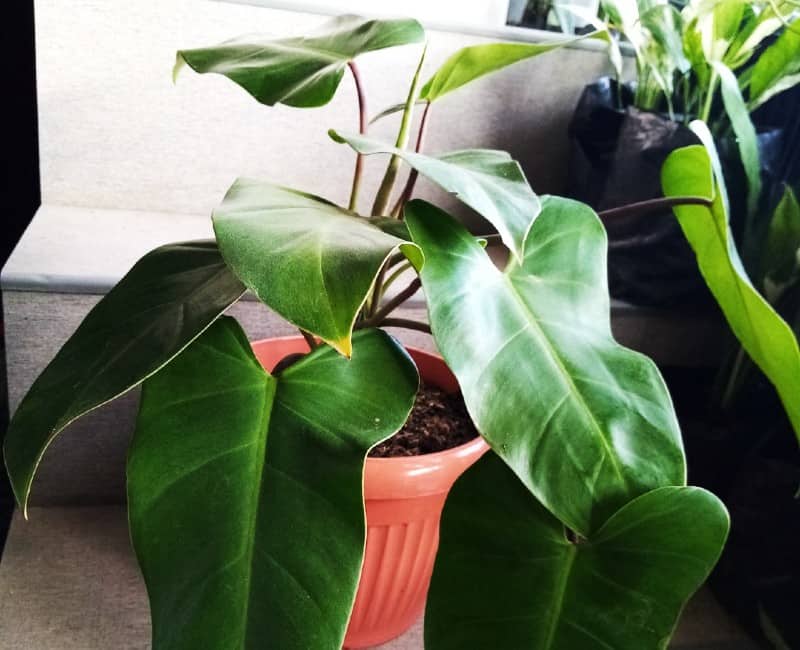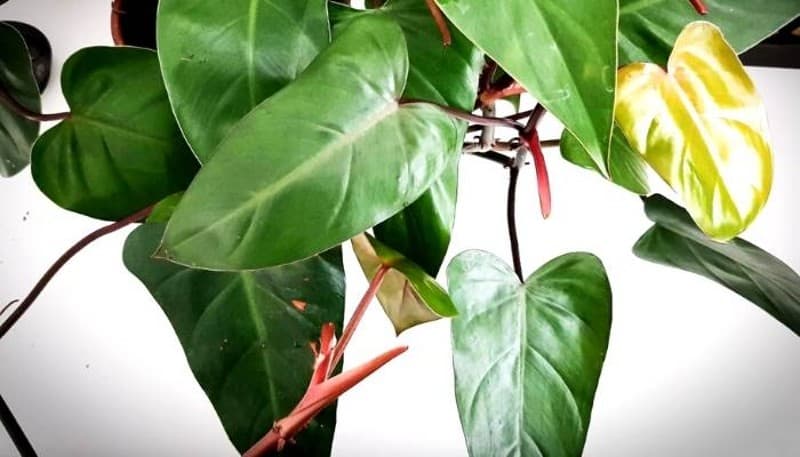No products in the cart.
Table of Contents
One thing is sure the Philodendron erubsescens is a vigorous climber. But it remains one of the most exotic tropical plants you can find.
The long narrow green leaves and red highlights provide a glamorous decor in the home. When it grows down a surface, you can notice the red-colored undersides to create a magnificent display.
What Is The Philodendron Erubescens
The tropical plant is native to Colombia, and people call it the red-leaf Philodendron. Now, you must not get confused with the red leaf Philodendron with a similar name but known as the Philodendron ‘Imperial Red’.
Prominent instances of Philodendron Erubescens include the Philodendron Black Cardinal, Philodendron Majesty, Dark Lord, the Philodendron Pink princess, and various other varieties displaying blushing or red hues.
When growing in the tropics, it can reach heights of 60 feet, converting to epiphytic growth. It has heart-shaped leaves with a dark green yet glossy look on top. At the bottom, the red comes over more burgundy.
Caring For Your Philodendron Erubescens

For the most part, the Philodendron erubescens is a collector’s plant. The foliage is cold and drought-tolerant compared to other species. It is a worthy indoor plant to grow and is relatively easy-going in the home.
Botanical Name: Philodendron erubescens
Common Name: Blushing Philodendrons, red-leaf Philodendron, imperial red Philodendron
Family: Buttercup family
Plant Type: Flowering Perennial
Native to: South America
Maximum Size: Up to 36-inches as an indoor plant
Watering Requirements: Keep soil moist but not soggy
Light Requirements: Partial shade
Preferred Humidity: High
Preferred Temperature: Warm
Soil or Potting Medium: Aroid plants mix
Fertilizer: Regular houseplant fertilizer
Propagation Method: Stem cuttings
Vulnerability: Overwatering
Toxicity: Toxic to humans and pets as all parts of the plant have calcium oxalate crystals
The Best Potting Mix for Blushing Philodendron Plant
As with most other aroid plants, the Philodendron loves to remain moist. But please do not saturate them with water as it leads to root rot.
Your plant needs a well-draining potting mix made up of organic matter and perlite. Providing your indoor plant with acidic yet neutral well-draining soil with a pH level between 5.8 to 7.5 will keep those aerial roots thriving.
Here are some perfect soil mixes you can try:
- You can mix soil using sphagnum moss.
- Or you can combine some vermiculite with perlite and peat in equal parts.
- If you already have mixed ground, you can add some sand to it for drainage.
- For store-bought earth mixes, you can get a succulent, orchid, or cacti potting mix.
Oh yes, and do not forget to provide your blushing beauty with a moss pole to creep along. Or you can always place them in hanging baskets.
Getting The Lighting Right

Most Philodendrons enjoy spreading out in medium-light to partial shade. Still, while your plant can tolerate bright indirect light, direct sun can damage the leaves as an outdoor plant.
So, the best is to provide them with filtered light instead of direct sunlight. For example, you can put your tropical plant 12 feet away from the window when placed indoors.
Doing this still leaves the foliage exposed to the rays of the sun. Too much sunlight turns the leaves yellow.
Watering Your Red Leaf Philodendron
Okay, your flowering plant is low-maintenance but can become prone to overwatering. The vining Philodendron prefers under-watering to keep them maintained.
Still, your red emerald-colored plant can withstand missed watering. It does not like its soil to dry out between watering. Too much water makes the foliage turn yellow, leading to root rot.
Ideal Temperature & Humidity
Great you have found a perfect spot in a well-lit room, creating a native environment for your blushing plant. Still, it helps to provide them with the right temperature and humidity simultaneously.

The Philodendron erubescens blushing plant thrives in warm temperatures. So, your plant will be at its happiest indoors in temperatures between 70° to 80° F.
Still, your plant can resist more eminent temperatures in indirect sunlight. But your plant is not a frost-hardy lover. Now, like most houseplants from the tropics, your plant loves humidity levels of 50%. But if you live in dry to freezing climates, it helps to have a hygrometer that is useful.
The apparatus informs you about the humidity to keep your plants happy as it adjusts measurements accordingly.
Feeding Your Plant
Your Philodendron plants are aggressive climbers and need nutrition to survive compared to other plants. You can feed them every month with a 15-15-15 fertilizer or a 10-10-10 feed reduced to half strength.
If you notice your plants not developing, you can increase the feed once every two weeks. Still, if you do not provide it with a good fertilizer will not die but only have slow growth.
Propagating Philodendron Erubescens
Okay, as a gardener, you do not only want one Philodendron erubescens. So, the best way is to propagate your plants using stem cuttings. The best part is we even have you covered with some detailed steps to do this.
- Select a strong stem with two to three leaf nodes.
- Using a sharp, sterilized knife cut about up to seven inches long cuttings.
- Prepare a container filled halfway with fresh potting soil and add water to moisten the ground.
- Remove the bottom leaves and place that end underneath the ground.
- Place the potting medium covered with a plastic bag in a humid environment with indirect sunlight.
- You should notice new growth in about 25 days.
- Once your cutting establishes white roots with shoots sprouting, you can repot your plant.
USDA Growth Zone

You can grow your Philodendron in the hardiness zones ten and eleven to provide you with flowers. Still, these flowers are not showy, but the leaves are.
Potting and Pruning Philodendrons
As a young plant, your Philodendron plants will continue to sprout and eventually surpasses the pot. As a result, you may find you need to repot them every year.
But if it has developed a mounting pattern climbing on moss poles. But if you do not want your plant to vine, you can prune it from time to time to keep it in shape.
You can also remove dead yellow leaves and prune the leggy stems.
Philodendron Erubescens Varieties
Most philodendron plants are resilient houseplants to take care of. Not only they’re low-maintenance but also beautiful too. Check these philodendron varieties you can bring home.
Philodendron Pink Princess
The Philodendron pink princess is beautiful when it grows as an indoor plant with its dark green leaves and variegation of pink. You can grow them in pots to hang from a macrame plant hanger with their trailing vines.
Red Emerald Philodendron
The Philodendron red emerald or Philodendron peperomia is another red variation evergreen plant. The foliage is dark green with a red stem.
Philodendron erubescens’Imperial Red’
The evergreen perennial also has a climbing habit with glossy new leaves that emerge red.
Diseases Philodendron Erubescens
As with other plants, you have some common pests and diseases to look out for:
Yellowed Leaves
The concern can happen for different reasons. For example, if your plant is in a dark location with constantly moist soil conditions, it leads to yellowing leaves. Even a mold buildup in the ground can be from too cold water leading to shock.
Other signs are too little feeding as it needs nourishment for the plant’s leaves to be robust.
Infestation of Pests
This can happen at any time, spreading from one indoor plant to another. Some pests that can deprive your Philodendron of nourishment are mealybugs and spider mites. You can spray your plant with neem oil to help stop the attack of these pests.
Root Rot
Yes, as with most plants sitting in water, it can lead to rotting of the roots. The leaves start turning yellow, and you notice a decaying brown base.
The best is to remove your plant from the pot and check if the roots are squishy and dark. Then, the best is to remove the disease’s tubers and take some cuttings.
Place your plant in fresh soil and make sure not to overwater your blushing plant.
Frequently Asked Questions
The Philodendron erubescens gold is known as the blushing Philodendron. It is also part of the Araceae family and a climber.
The easy plant prefers partial shade to bright sunlight—too much direct sunlight damages the leaves
The species you can identify with its dark green leaves in the shape of an elongated heart or arrowhead. The blushing comes from the red-purple underside of the foliage.
If you want new plants in the Philodendron collection, you can find them at your local garden center. Or you can browse through Plantly’s indoor and outdoor plant collection to buy one.
Whether you want to buy, sell or simply reach out to other plant enthusiasts, Plantly is the right place to be!


